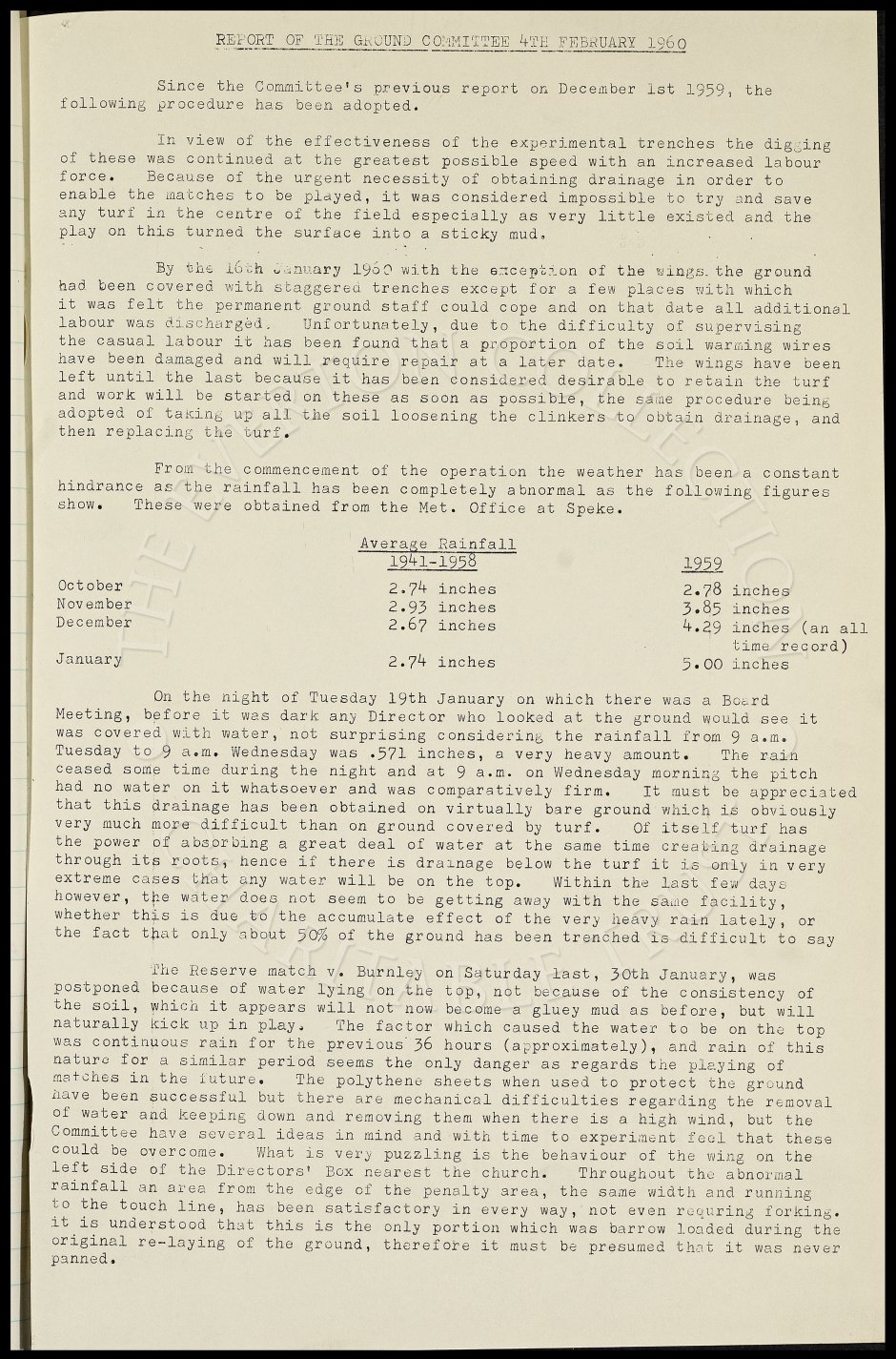
REPORT OF THE GROUND COMMITTEE 4TH FEBRUARY 1960 Since the Committee's previous report on December 1st 1959, the following procedure has been adopted. In view of the effectiveness of the experimental trenches the digging of these was continued at the greatest possible speed with an increased labour force. Because of the urgent necessity of obtaining drainage in order to enable the matches to be played, it was considered impossible to try and save any turf in the centre of the field especially as very little existed and the play on this turned the surface into a sticky mud. By the 16th January 1960 with the exception of the wings, the ground had been covered with staggered trenches except for a few places with which it was felt the permanent ground staff could cope and on that date all additional labour was discharged. Unfortunately, due to the difficulty of supervising the casual labour it has been found that a proportion of the soil warming wires have been damaged and will require repair at a later date. The wings have been left until the last because it has been considered desirable to retain the turf and work will be started on these as soon as possible, the same procedure being adopted of taking up all the soil loosening the clinkers to obtain drainage, and then replacing the turf. From the commencement of the operation the weather has been a constant hindrance as the rainfall has been completely abnormal as the following figures show. These were obtained from the Met. Office at Speke. Average Rainfall 1941-1958 1959 October 2.74 inches 2.78 inches November 2.93 inches 3.85 inches December 2.67 inches 4.29 inches (an all time record) January 2.74 inches 5.00 inches On the night of Tuesday 19th January on which there was a Board Meeting, before it was dark any Director who looked at the ground would see it was covered with water, not surprising considering the rainfall from 9 a.m. Tuesday to 9 a.m. Wednesday was .571 inches, a very heavy amount. The rain ceased some time during the night and at 9 a.m. on Wednesday morning the pitch had no water on it whatsoever and was comparatively firm. It must be appreciated that this drainage has been obtained on virtually bare ground which is obviously very much more difficult than on ground covered by turf. Of itself turf has the power of absorbing a great deal of water at the same time creating drainage through its roots, hence if there is drainage below the turf it is only in very extreme cases that any water will be on the top. Within the last few days however, the water does not seem to be getting away with the same facility, whether this is due to the accumulate effect of the very heavy rain lately, or that fact that only about 50% of the ground has been trenched is difficult to say The Reserve match v. Burnley on Saturday last, 30th January, was postponed because of water lying on the top, not because of the consistency of the soil, which it appears will not now become a gluey mud as before, but will naturally kick up in play. The factor which caused the water to be on the top was continuous rain for the previous 36 hours (approximately), and rain of this nature for a similar period seems the only danger as regards the playing of matches in the future. The polythene sheets when used to protect the ground have been successful but there are mechanical difficulties regarding the removal of water and keeping down and removing them when there is a high wind, but the Committee have several ideas in mind and with time to experiment feel that these could be overcome. What is very puzzling is the behaviour of the wing on the left side of the Directors' Box nearest the church. Throughout the abnormal rainfall an area from the edge of the penalty area, the same width and running to the touch line, has been satisfactory in every way, not even requiring forking. It is understood that this is the only portion which was barrow loaded during the original re-laying of the ground, therefore it must be presumed that it was never panned.
